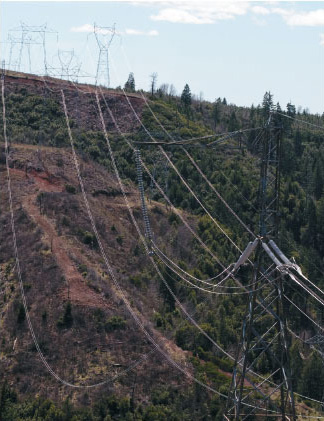Data, Computation and the Ability to Anticipate Risk
Technical resiliency as it applies to the transmission and distribution industry across the United States has taken on new meaning in the last decade. In the past, utility owners counted on intrusive testing and regular physical inspection with boots on the ground to maintain their transmission and distribution assets. Owners had invested millions in creating maintenance programs that regularly resulted in the upgrade of transmission and distribution lines due to noticed existing damage on conductors, structures and locations where a known flashover due to vegetation growth had been reported. These assessments and the remediation performed for the assessments have largely been reactive due to the reporting of a problem rather than proactive in anticipation of a future issue.
There will always be a need for maintenance programs within utility owners’ systems to routinely perform physical inspection on assets. However, with the increases in technology such as aerial LiDAR, dimensionally accurate high-resolution photographs, drone investigations, machine learning and increased power in data sorting and analytics, utility owners can now be less reactive in their assessments and more proactive in understanding their transmission and distribution systems for future risks. As the technology associated with the reconnaissance of field data has decreased in cost and increased in accessibility over the last 10-20 years, the computational methodology and ability to model and provide proactive technical solutions to existing threats within a transmission or distribution system has also improved.
In the early 2000s, performing a reliability model for an existing transmission line depended on the capture of existing points with photogrammetry or ground survey. While these acquisition methods are still being used in today’s power delivery industry, LiDAR surveying and drone data acquisition have begun to usurp some of these traditional methods of data capture. Lines being modeled and sagged in computational software with three to five points captured on them per span in comparison to receiving data that has up to 100-200 points per catenary have greatly increased the accuracy of identifying the installed tensions of a line, which can give engineers a high level of precision and greater comfort level to definitively state when a line may experience a clearance issue or a structure loading issue in the future. With these increases in the reliability of data, engineers can now more conclusively give recommendations not only for existing system limitations but for how transmission and distribution assets may react to future weather or physical loading events.
ONE STEP AT A TIME

The greater utility industry has understood the need for increased reliability and ultimate system resiliency due to high profile fires and blackouts identified from transmission failures in the past. The 2003 Eastern Interconnection blackout, recent wildfires in the west and damages caused by the recent winter storms in Texas in 2021 have spurred the need to identify future risk. In 2010, the North American Electric Reliability Corporation (NERC) published its Industry Advisory Bulletin to Transmission Owners requesting them to review their transmission vegetation management practices. The advisory largely brought into focus lines with Category 1 issues (grow ins of vegetation within the ROW), Category 2 (fall ins of vegetation within the ROW) and Category 3 (fall ins of vegetation from outside the ROW). These issues resulted in many utilities contracting out LiDAR survey reconnaissance for their entire transmission system. Over the next several years, utilities performed clearance analyses on existing transmission assets to identify where there were vegetation clearance infringements and clearance to ground issues. The utilities then subsequently began to adhere to a consistent schedule of collecting data on their assets over a period of time to maintain an ability to perform vegetation and clearance analyses in the future.
The industry grew through the lessons learned of the NERC assessments and utility owners, consultants and software developers worked towards creating technical solutions and improvements in the process of the modeling and identification of reliability issues. One of the limitations of the NERC assessment was the void of any active analysis of structural issues on the lines. Many utility owners and consultants understood that just as clearance issues to vegetation could cause system failures, a structure, hardware or insulator failure could also lead to an equally onerous reliability issue. These structural components also needed to be investigated and remediated for achieving total system resiliency. These needs for increased analysis expanded well beyond the 230kV-500kV target areas and the investigations into clearance and structural issues needed to expand to a utility’s entire system, in some cases, even to the distribution voltage levels.
IMPROVEMENTS IN RESILIENCY ARE NECESSARY
The modeling of existing lines and structures accurately comes with many challenges. Often, data for existing structures has been archived, lost or has not been updated and cataloged in the correct location as maintenance has occurred on the line. Drawings of existing structures, plan and profiles, staking sheets and GIS information may not be readily available for performing the necessary modeling of structures without the verification of the data in the field. Field verification of the structure data can come by the identifiable marks on a structure, ahead and back span length checks, structure height checks, diameter measurements of poles and other quantifiable data. These pieces of data combined with the LiDAR reconnaissance and other scientific measurement such as intrusive testing on wood pole structures or ultrasonic measurement to determine any section loss of steel on poles or towers will give a more accurate picture of the model to match field conditions to analyze against the design load or code required weather conditions and loading.
Once the data is compiled and verified, modeling efforts can commence that will accurately show not only the sag of the wires and tensions to the surveyed data, but ultimately the effect of the design load cases on the structures analyzed by finite element software. These pieces of analysis may show that an insulator may be overstressed in certain load conditions, guy wires were not installed correctly, a structure has a phase to ground clearance issue due to the installation compared to the original design, or potentially a structure is overloaded. All of these structural issues would not have been seen without the combination of multiple sources, but when analyzed per the appropriate loading requirement can show an in-situ picture of the utility’s potential risk of failure. This risk of failure or a future high-risk event should drive the stakeholders of the utility to prioritize the needs of the system for safe and reliable transmission and distribution operation assets.
The American Society of Civil Engineers (ASCE) is also doing its part to strive towards a more resilient electrical system within the United States. At the end of 2020, ASCE announced its push to change the Guidelines for Electrical Transmission Line Structural Loading – Manuals and Reports on Engineering Practice No. 74 from a “Manual and Report” to a governing “Standard.” This change will alter some of the minimum requirements engineers and utilities adhere to today out of ASCE 7 and require those minimum loading standards to come from a future version of ASCE 74, which will have transmission-specific loading requirements and weather cases for the industry.
ANTICIPATING RISK
The challenge for the utility industry moving forward is not only identifying the existing clearance or structural issues within their systems, but to anticipate future high-risk events that may cause a potential safety or reliability issue. Many utilities are moving towards a reliability model that will identify risk and work towards prioritizing the critical replacement of pieces of infrastructure once a total analysis has been performed on the complete system. This way, critical infrastructure concerns are remediated first with less critical items being remediated on a more realistic timeline and when the budget is available. To perform this analysis, utilities have enlisted the help of engineering consultants, meteorologists, statisticians and experienced utility stakeholders who know and understand the limitations of their systems and can prioritize the asset management needed to perform these studies.
Modeling analyses for these simulations have not only considered code required design cases to determine where a structure or line may have identified issues against the originally designed recurrence interval (typically a 50-year or 100-year storm), but have now modeled and tracked the resiliency of the system from minimal wind/ice loading conditions to extreme conditions in intervals of 5-10 mph increments. Generating these weather cases from high probability (low loading) to lower probability (high loading), creates multiple scenarios of load cases and gives the utility owner an identifiable benchmark of where risk may begin to develop in a certain location and with a certain loading. The utility can then compare the probability of a storm of the nature it will take to cause an outage or potential high-risk event. This can be compared to historical data and also tracked and anticipated against forecasted weather events.
The ability to anticipate a potential electrical failure during a high wind event through a high fire threat zone can also provide valuable information to the decision-makers of utilities to reduce the need for public safety power shutoffs, reduce fire risk due to a flash over or failure of a transmission system and create a more reliable and resilient system for utilities of today.
This type of proactive analysis can aid a utility with predicting future storm events such as a hurricane. A hurricane’s wind speed, location of the storm and timing of storm can be used to model against the performance of the transmission asset and produce data that can be used to make high level power shut-off and power-routing decisions by the utility operator in the case of an actual event. The same type of analysis can also be performed for unexpected winter storms where the predicted ice accumulations may exceed that of the system’s structural capacities. The identification of at-risk infrastructure can then be used to increase power transfer on some of the lines by re-routing power such that high-profile transmission lines have higher current flowing through them, which in turn will aid in abating ice accumulation.
The ability to anticipate a potential electrical failure during a high wind event through a high fire threat zone can also provide valuable information to the decision-makers of utilities to reduce the need for public safety power shutoffs, reduce fire risk due to a flash over or failure of a transmission system and create a more reliable and resilient system for utilities of today.
Ultimately, the modern utility of today should maintain inspection and maintenance protocols they have developed in the past, while keeping accurate records of line upgrades, change outs and as-built records. These pieces of physical inspection data and records of past work create vital information for advanced modeling techniques that can create critical data and conclusions for the resiliency of a transmission and distribution system for the future. The analyses performed with this data can greatly reduce the possibility of future outages and continue to give safe and reliable power to the stakeholders who matter for the utility the most, the ratepayer.

